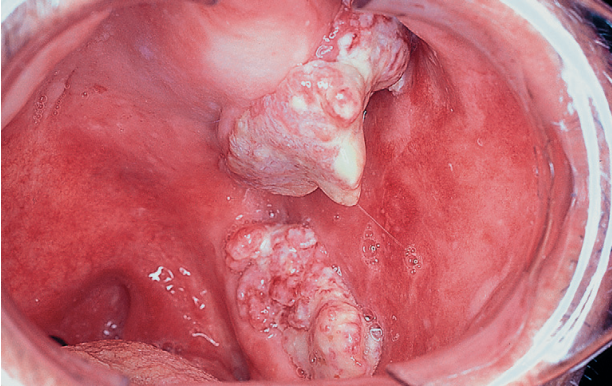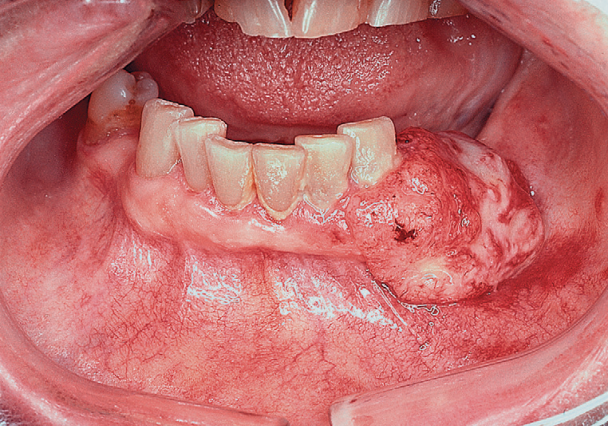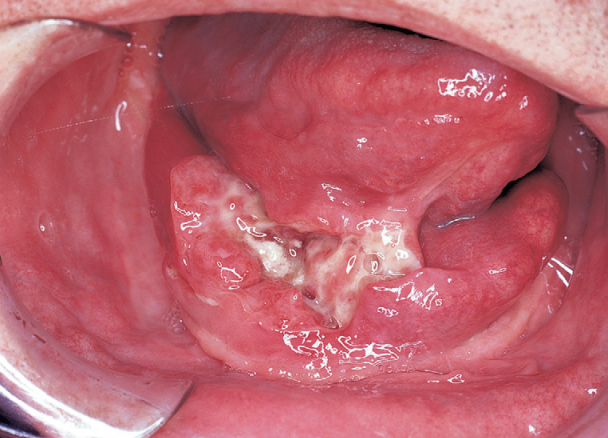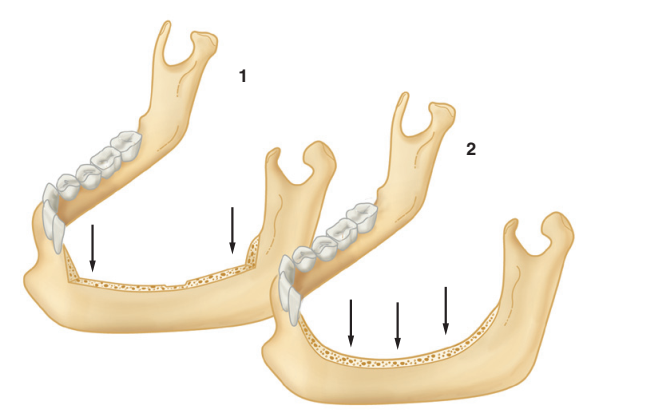gum cancer
OVERVIEW
What is gum cancer?
Gum cancer is a malignant tumor that grows on the gums.
What is the difference between gum cancer and oral cancer?
Oral cancer is a general term for malignant tumors that occur in the oral cavity, including gum cancer, tongue cancer, cheek cancer, etc. Gum cancer may appear as an outward-growing protrusion resembling a cauliflower or as a non-healing ulcer.
People aged 40–60 are more susceptible to gum cancer, with a higher incidence in men than women. The lower jaw is more commonly affected than the upper jaw. Treatment usually involves a comprehensive approach, with surgery as the primary method.
Generally, gum cancer surgery involves the removal of part of the teeth, gums, and jawbone, leading to varying degrees of impairment in eating, speaking, and other oral functions, which affects quality of life. The prognosis is relatively better compared to cancers in other areas, such as stomach or lung cancer. The 5-year survival rate is approximately 62.5%.

 !
!

Is gum cancer common?
The incidence of gum cancer is relatively low, approximately 0.5 per 100,000 people.
What factors can easily trigger gum cancer?
It is mainly induced by long-term smoking, alcohol consumption, or wearing ill-fitting dentures. It can also develop from precancerous lesions of the oral mucosa, such as leukoplakia.
How is gum cancer staged?
Based on the size of the gum cancer and the presence of lymph node or distant metastasis, it can be divided into early, middle, and late stages.
- Early stage: The diameter of the gum cancer is less than 4 cm, with no lymph node or distant metastasis.
- Middle stage: The diameter of the gum cancer is greater than 4 cm, or there is lymph node metastasis but no distant metastasis.
- Late stage: Regardless of the size of the gum cancer or lymph node involvement, the presence of distant metastasis indicates a late stage.
SYMPTOMS
What are the manifestations of gingival cancer?
The most common manifestations of gingival cancer are outward-growing protrusions or long-term non-healing ulcers.
Patients may experience pain in the gums or teeth. As gingival cancer grows, cauliflower-like protrusions may appear on the gums, or ulcers may enlarge. Teeth near the protrusions or ulcers may become loose, and patients may feel weak when biting food.
What serious consequences can gingival cancer cause?
- Difficulty opening the mouth: When gingival cancer located toward the back invades the muscles responsible for opening the mouth, patients may struggle to open their mouth fully, affecting eating, drinking, and speaking.
- Jaw fracture: If gingival cancer deeply erodes the mandible, it may cause a fracture when opening the mouth wide or chewing. Some patients are diagnosed with gingival cancer only after seeking treatment for a jaw fracture.
- Bleeding: When gingival cancer grows large, the tumor surface may rupture and bleed profusely, filling the mouth with blood within seconds.
- Pain: In advanced stages, gingival cancer may invade nerve fibers, causing severe pain.
- Metastasis: Gingival cancer mainly metastasizes to cervical lymph nodes, with distant metastasis being rare.
- Cachexia: If untreated or metastasized, gingival cancer can lead to severe weight loss, failure of vital organs like the liver or lungs, and eventually death.
What symptoms should raise suspicion of gingival cancer?
- A gum ulcer that does not heal in 2–3 weeks and continues to grow.
- Sudden pain in previously painless white patches on the gums.
- Unexplained tooth pain and loosening without cavities or periodontal disease.
- Jaw fracture when biting hard food without prior trauma.

CAUSES
What Causes Gum Cancer?
The causes of gum cancer include the following aspects:
- Long-term smoking and excessive alcohol consumption: Prolonged heavy smoking and drinking increase the risk of gum cancer.
- Chronic betel nut chewing: Chewing betel nuts not only exerts long-term chronic mechanical irritation on the gums but also introduces chemical substances that can trigger gum cancer.
- Ill-fitting dentures: Poorly made dentures may have sharp edges or protrusions, causing long-term chronic mechanical irritation to the gums, which can also induce gum cancer.
- Malignant transformation of mucosal diseases like leukoplakia: Leukoplakia is a precancerous lesion, and its presence on the gums is a potential factor for gum cancer.
Who Is More Prone to Gum Cancer?
Gum cancer is more common in people aged 40–60, with a higher incidence in men than women. Those who smoke, drink excessively, or chew betel nuts long-term are at greater risk.
Is Gum Cancer Hereditary?
Gum cancer is not a genetic disease and cannot be inherited.
DIAGNOSIS
How to Determine if Gum Cancer is Primary or Metastatic?
Whether gum cancer is primary is determined by pathological testing. A small tissue sample is taken from the lesion site for pathological examination to confirm if the gum lesion is cancerous.
Generally, clinical examinations by doctors, auxiliary tests (such as ultrasound, CT, MRI, PET-CT, etc.), blood tests, and biopsies can be used to determine the presence of tumors elsewhere in the body.
In most cases, these tests can confirm whether tumors exist in other areas. However, in rare instances, metastatic cancer may be detected without identifying the primary cancer.
How is Gum Cancer Diagnosed?
The gold standard for diagnosing gum cancer is pathological testing.
Tests like ultrasound, CT, MRI, and PET-CT are auxiliary. While they may suggest the presence of a tumor, pathological testing is ultimately required for confirmation.
Which Oral Diseases Are Easily Confused with Gum Cancer?
Early-stage protruding gum cancer and gum tumors can be visually similar. However, gum cancer typically grows rapidly, potentially increasing from the size of a soybean to that of a broad bean or even a pigeon egg within weeks or a month, accompanied by noticeable pain.
Gum tumors grow more slowly, taking several months or longer to reach the size of a soybean, often without causing pain.
Necrotizing gingivitis and ulcerative gum cancer can appear similar. Necrotizing gingivitis usually starts between the gum papillae or teeth, causing severe pain, excessive saliva, and noticeable bad breath.
Early gum cancer can be confused with periodontal disease. X-rays can help differentiate them: periodontal disease causes regular alveolar bone resorption, while gum cancer leads to irregular, borderless bone destruction.
Advanced gum cancer may resemble maxillary sinus cancer or central jaw cancer, especially when surrounding tissues are severely damaged. Comprehensive evaluation, including symptoms and CT scans, is needed for differentiation.
Which Diseases Can Develop into Oral Cancer?
- Leukoplakia: White patches on the gums may become malignant due to stimuli like tobacco, alcohol, or betel nuts, turning into gum cancer.
- Chronic mechanical irritation-induced ulcers: Poorly fitted dentures or sharp tooth edges causing prolonged irritation may lead to gum cancer.
Is a Fleshy Lump on the Gums Always Gum Cancer?
Most fleshy lumps on the gums are not gum cancer; only a very small fraction may be cancerous. Common conditions include gum tumors, gum polyps, and dental pulp polyps.
How to Detect Gum Cancer Early?
- If experiencing gum or tooth pain, avoid self-medicating with "anti-inflammatory" or "pain relief" drugs. Instead, seek medical attention.
- Regular oral health check-ups: Routine exams can detect mild lesions early, enabling timely treatment and better outcomes.
TREATMENT
Which department should I visit for gum cancer?
For gum cancer, you should go to the oral and maxillofacial surgery department of a specialized dental hospital or the stomatology department of a general hospital.
What are the advantages, disadvantages, and indications of surgical treatment and radiotherapy/chemotherapy for gum cancer?
Most gum cancers are squamous cell carcinomas, which are not sensitive to radiotherapy or chemotherapy. Additionally, since the gum tissue covers the jawbone, radiotherapy can easily lead to radioactive osteomyelitis and bone necrosis. Therefore, surgical treatment is currently the primary approach for gum cancer.
How is the treatment plan for gum cancer determined?
For early and mid-stage gum cancer, surgical treatment is generally used. For advanced gum cancer, surgery is the main treatment, followed by radiotherapy and chemotherapy.



What are the potential risks of surgical treatment and radiotherapy for gum cancer?
Surgical treatment
- Loss of function: After surgery, the removal of gum tissue, alveolar bone, and mandible may affect functions such as eating and speaking.
- Facial deformity: If the affected area is large, more tissue may need to be removed, leading to defects in the upper or lower jaw and affecting facial appearance.
- Anesthesia risks: Gum cancer surgery is performed under general anesthesia, which carries certain risks, such as cardiovascular accidents or respiratory infections.
Radiotherapy
- Osteomyelitis and bone necrosis: Radiotherapy can cause necrosis and chronic osteomyelitis in the remaining jawbone, leading to swelling, pain, and long-term pus discharge.
- Skin hardening, roughness, and ulcers: The skin in the irradiated area may become hardened and rough, and severe cases may develop non-healing ulcers.
What is the 5-year survival rate for surgical treatment of gum cancer?
The 5-year survival rate refers to the percentage of patients who survive for 5 years or more after treatment for a specific disease.
The 5-year survival rate for early-stage gum cancer is approximately 80% or higher, while for advanced gum cancer, it is around 60%.
Can gum cancer recur after treatment? How likely is recurrence?
Gum cancer may recur after treatment, with a recurrence rate of about 15%.
DIET & LIFESTYLE
What should gum cancer patients pay attention to in daily life to reduce recurrence rates?
- Positive and optimistic emotional state: Maintaining a positive and optimistic emotional state can improve the quality of life for gum cancer patients, enhance their disease resistance, promote recovery, and reduce recurrence after treatment.
- Balanced diet: Avoid spicy and irritating foods. Maintain a balanced diet and strengthen nutrition.
- Moderate exercise: Moderate exercise can improve physical fitness, boost immunity, and aid in the recovery of gum cancer while reducing recurrence.
- Regular follow-ups and health check-ups: Regular health check-ups and dental follow-ups can help detect hidden issues early and allow timely medical intervention to reduce recurrence.
How often should gum cancer patients undergo follow-up examinations after treatment?
Gum cancer patients need regular follow-up examinations after completing treatment. Typically, follow-ups are scheduled at 3, 6, and 9 months, and 1, 2, 3, and 5 years post-treatment.
Main components of follow-up examinations include:
1. Clinical examination by a doctor:
- Wound healing status;
- Survival of flaps (tissue flaps) (extensive gum cancer cases may require flaps to repair defects from surgical removal);
- Position of reconstruction plates (in some cases, titanium plates are used to repair mandibular defects after resection);
- Condition of the dental ridge to determine suitability for dentures;
- Recovery of functions such as speech and eating;
- Patient's confidence and mindset regarding recovery.
2. CT, ultrasound, chest X-rays, etc.: To check for swollen lymph nodes in the neck or metastases in other areas.
3. Blood tests: Complete blood count, liver and kidney function, tumor markers (typically squamous cell carcinoma antigen for gum cancer).
PREVENTION
How to prevent gum cancer?
Both ordinary people and high-risk groups should prevent gum cancer by addressing its causative factors:
- Avoid tobacco and drink alcohol in moderation.
- Refrain from chewing betel nut or quit the habit.
- Maintain a balanced diet and exercise appropriately.
- Stay optimistic and keep a cheerful mood.
- If dentures are uncomfortable or ill-fitting, seek medical attention promptly for adjustments.
- Treat decayed teeth, leukoplakia, or other oral issues in a timely manner.
How to prevent complications during the progression of gum cancer?
- Consume soft foods and avoid dry, hard chunks to prevent irritation, bleeding, or spread.
- Avoid excessive mouth opening or forceful chewing of hard foods to prevent jaw fractures.
- Maintain a balanced diet and proper nutrition—avoid misconceptions like "starving" cancer cells.
How to prevent the infiltration and metastasis of gum cancer?
Before diagnosis, avoid self-stimulation such as pricking, squeezing, or scratching gum ulcers or protrusions.
In extreme cases where large protrusions interfere with eating or speaking, do not attempt to "trim" them with blades or scissors, as such actions may accelerate infiltration and metastasis.